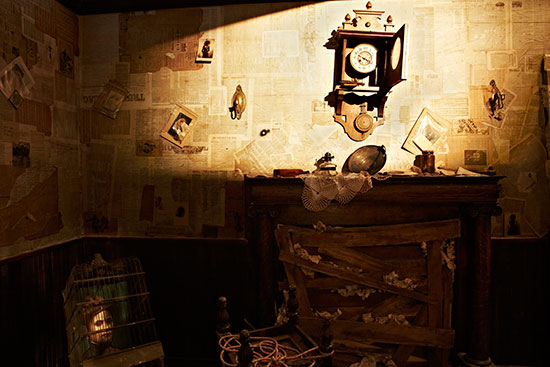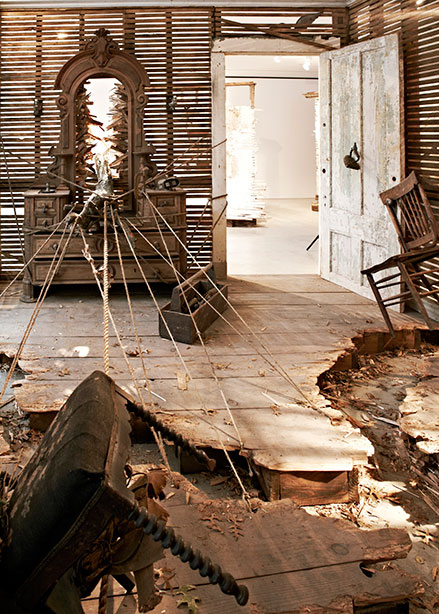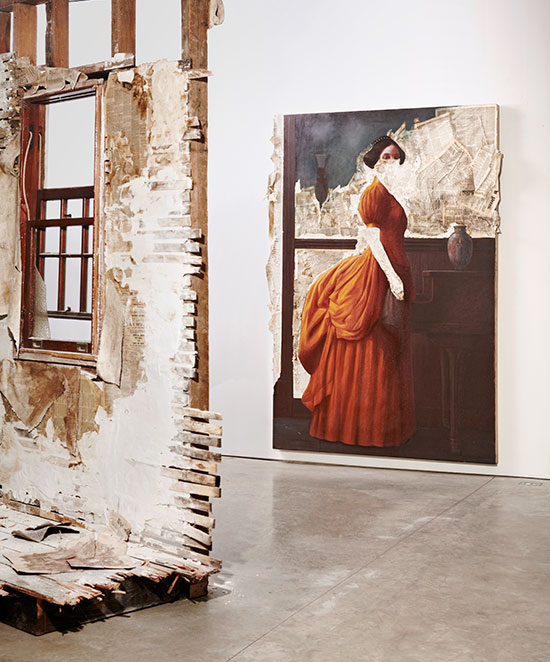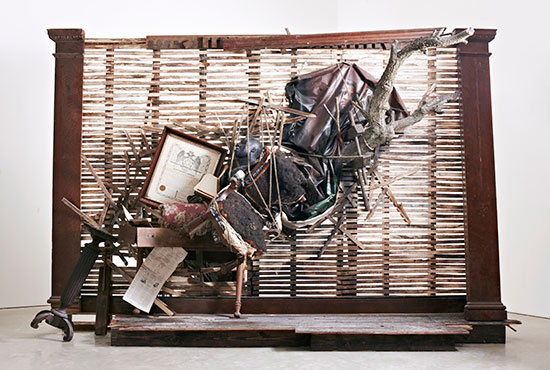At the opening reception for "Titus Kaphar: The Vesper Project" at Lowe Art Museum of the University of Miami, artist Titus Kaphar looked relaxed. Wearing a fedora and stylish black sneakers with rawhide laces, he chatted comfortably about his remarkable project—five years in the making—melding painting, sculpture, and found objects.
Kaphar's accessible manner contrasted with the raw and tender aura of The Vesper Project. In this large-scale installation, living spaces are deconstructed in profound upheaval. They're scattered with disfigured portraits and all manner of 19th century artifacts, from newspapers to clocks to tattered Oriental rugs to a manual typewriter.
.

Installation shot of "Titus Kaphar: The Vesper Project" at Lowe Art Museum, University of Miami. Courtesy of Lowe Art Museum.
.

Installation shot of "Titus Kaphar: The Vesper Project" at Lowe Art Museum, University of Miami. Courtesy of Lowe Art Museum.
.
"Don't really think of it as a space," Kaphar said, gesturing to an open doorway, leading to a tempestuous rubble of time and place. Doors are nailed to the few remaining ceiling beams, antique furniture is battered and tossed, a fireplace can't function with its hearth clumsily papered shut—resembling a giant gagged mouth. "Imagine that you are walking through someone's mind,” he said. “Go in there and just imagine you are perusing someone's mind."
This is a mind in distress, reeling from vast loss.
.

Installation shot of "Titus Kaphar: The Vesper Project" at Lowe Art Museum, University of Miami. Courtesy of Lowe Art Museum.
.
The rooms were open that night for the evening's astonishing excerpt from a performance by Miami's Peter London Global Dance Company scheduled at the Lowe on October 15, 2016. Now visitors can take only a few steps inside, halted by a sly allusion to grand rooms in historical homes where visitors must peer over velvet ropes to see what's inside. No velvet here: this rope is coarse, fraying. More of it is inside, snaking carelessly around objects.
Amid the chaos, the viewer can't miss painterly examples of Kaphar's distinctive take on 19th century portraits. The artist clearly understands traditions set by icons of American portraiture. He's infused art history with deft present-day references, suggesting how a "whites only" legacy has distorted our sense of history, leaving many gaps created by untold stories.
He's made a name for himself with paintings that have been creased and cut, dipped in tar and whitewashed. Often they are collaged with scraps of newspapers so that mouths are silenced.
.

Installation shot of "Titus Kaphar: The Vesper Project" at Lowe Art Museum, University of Miami. Courtesy of Lowe Art Museum.
.
His own legacy? To create new stories, weaving poetic imagery into the texture of time damaged by exclusive narratives. In doing so, he evokes destructive forces that created histories pockmarked with gaping holes left by stories we never knew.
Kaphar is clearly an artist rising in prominence, as information provided by his New York gallery Jack Shainman indicates. In late 2014, Time magazine commissioned him to create art in response to protests in Ferguson, MO. Solo exhibitions at Studio Museum in Harlem and Seattle Art Museum have presented his work, among other venues. His art is included in collections of New York's Museum of Modern Art, New Britain Museum of American Art in New Britain, CT, Pérez Art Museum Miami, Seattle Museum of Art, and Studio Museum in Harlem.
In "The Vesper Project" Kaphar builds an imaginative re-creation of what the past might have been, fashioned from historical artifacts transported to his studio. Many of these are remnants salvaged from an abandoned 19th century wood-frame home Kaphar found in Connecticut. The show also includes spectral photographs of the home itself, barely visible among trees.
Here's a brief outline of the story Kaphar devised to underpin his compelling fusion of past and present: The house belonged to the Vespers, descendants of a Brazilian slave. They've passed for white and lived a comfortable life thanks to their prosperous shipping business in New England immediately after the Civil War. After the discovery that they are "passing," their fortunes are ruined.
Kaphar's storyline has been compared to novels by Toni Morrison and William Faulkner. It's important, though, that viewers not get tangled into trying to find literal clues to substantiate this fictional story.
As the artist said on that opening night at the Lowe, "I'm not getting into the specifics of fact and time. My job as an artist is to produce the work and open the door. I don't have to have all the answers."
He's opened the door to an emotional path for contemplating historical roots underlying racial clashes and violence disfiguring life in this country's recent past. The bold outlines of Kaphar's tale are ingeniously evoked in the art itself via violated architecture of the home and its chaotic interior.
"The Vesper Project" is a kind of stage set, depicting a once comfortable home of more than a century ago that's now ravaged, with daylight piercing decrepit walls and dried leaves blown inside by ill winds. Left on the floor is Kaphar's portrait of a woman with a prim 19th century coiffure. Thrown over the portrait is a rusty bird cage, so it's hard to see her face clearly. Another portrait, housed in a grand gilt frame, has been sliced so that the face droops towards the floor, precariously upside down.
Embedded in meticulous, almost quaintly vintage details is a painful legacy of hypocrisy and dashed dreams.
"The Vesper Project" was first exhibited in 2013 at New York gallery Friedman Benda, garnering significant press. A year later, it began a tour of several museums. Now it has reached the Lowe, where it remains on view through December 23, 2016. Complementing its presentation at the Lowe are Kaphar's 2012 paintings Watching Tides Rise and Front Page.
.

Installation shot of "Titus Kaphar: The Vesper Project" including "Front Page" at Lowe Art Museum, University of Miami. Courtesy of Lowe Art Museum.
.
In Front Page, he renders a stylish 19th century woman who could have belonged to the Vesper family, although the painting is not technically part of "The Vesper Project." But the spirit and formal techniques of this striking painting make it fully in synch with Kaphar's ambitious installation, a milestone in his career.
Typically, much of her face, except for the eyes, is hidden, this time by an overlapping swath of collaged newspapers. It extends over her torso and blocks off much of the background. Her forearm and hand are similarly obscured, first suggesting a white evening glove, then evoking a bandage or elaborate restraint.
With face and arms covered by shredded newspapers, costuming for the lithe dancers of Peter London Global Dance Company in the October 15, 2016 performance echoed Front Page.
Despite Kaphar's painterly skills, the woman in Front Page seems oddly disconnected from her surroundings. Her ability to speak is muzzled, her physical movement stifled. To continue the title's journalistic metaphor, this front page story has been spiked.
Newspapers—shredded, clipped, cut, folded and unfolded—are a constant presence in this exhibit. So are books with dusty yellowed pages. These long-ago print artifacts appear to align Kaphar's art with the truth-telling mission of journalism, even though the artist's take on past and present realities is spliced with sharp irony.
Continuing Kaphar's journey back in time: Part of this installation shows bare horizontal slats of an interior wall, lashed with ropes encircling a hodge-podge of domestic period furnishings, including a sculpted bust of a black man and a rolled up rug. Framed on the wall is an elaborate document dated July 20, 1883, announcing someone's membership in the Ancient Accepted Scottish Rite of Freemasonry, an organization surely reflecting the era's segregationist attitudes.
.

Installation shot of "Titus Kaphar: The Vesper Project" at Lowe Art Museum, University of Miami. Courtesy of Lowe Art Museum.
.
Folded nearby is a yellowed February 22, 1871, copy of The Constitution newspaper from Middletown, CT, with front-page ads for overcoats and patent medicine. From today's perspective and in this context, the newspaper's title could seem another example of Kaphar's irony regarding constitutional rights historically denied African Americans.
The other side of this interior wall displays a grim, intricate tableau. A dark brown, shrouded figure whose face can't be seen is hunched in a vintage wooden wheel chair, next to a table adorned with old-time black and white photographs of white men posing to show off their athletic physiques. This anonymous, crippled figure seems to mourn lost opportunities.
Kaphar's art excavates layers of truth about what was acceptable then and now. With its raw and tender beauty, his art gives viewers serious pause in the wake of racial tensions too often inflaming today's headlines.
.

Installation shot of "Titus Kaphar: The Vesper Project" at Lowe Art Museum, University of Miami. Courtesy of Lowe Art Museum.
.
___________________________________
BASIC FACTS: "Titus Kaphar: The Vesper Project" is on view September 8 through December 23, 2016, at Lowe Art Museum, University of Miami, 1301 Stanford Drive, Coral Gables, FL 33124-6310. www.miami.edu/lowe Peter London Global Dance Company will offer an interpretation of “The Vesper Project” at 6:30 p.m. on Saturday, October 15, 2016.
___________________________________
Copyright 2016 Hamptons Art Hub LLC. All rights reserved.
